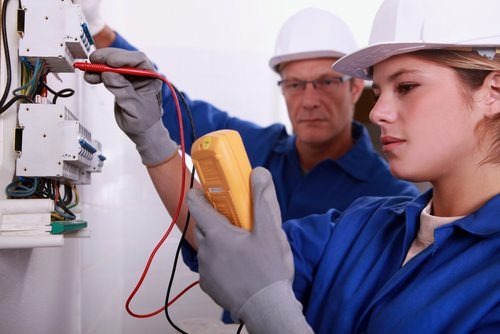
It doesn’t take a genius to figure out that electricity is dangerous, and should not be messed with. In most scenarios, it’s best to call and electrician to help out. But here are 21 general safety rules that you can follow to keep yourself and your family safe at all times.
Rule #1:
Avoid wearing loose clothing near electrical equipment.
Rule #2:
De-energise open experimental circuits and equipment to be left unattended.
Rule #3:
Know your switchboard: Interlocks on equipment disconnect the high voltage source when a cabinet door is open but power for control circuits may remain on! Be careful as this could mean live electricity is still going through the equipment.
Rule #4:
Do not store highly flammable liquids near electrical equipment.
Rule #5:
If it’s necessary for you to touch electrical equipment (eg. when checking for overheated motors), use the back of your hand. This is so that if accidental shock causes any muscle contraction, your muscle doesn’t contract to the conductor.
Rule #6:
No liquids! Water is an excellent conductor. Do not touch electrical equipment if you have wet hands, feet, body, or are perspiring. It’s always best to wear gloves and shoes.
Rule #7:
Keep all electric contacts and conductors enclosed so that no one can accidentally come into contact with them.
Rule #8:
Never touch someone else’s equipment or electrical control devices, unless you are specifically asked to. Take precautionary measures if this is the case.
Rule #9:
Drain capacitors before working near them and keep the short circuit on the terminals during the work to prevent electric shock.
Rule #10:
Don’t rely on grounding alone to mask a defective circuit, also don’t attempt to correct a fault by inserting another fuse or breaker. If you need to correct a fault – call an electrician.
Rule #11:
If equipment is producing a “tingle”, it should be immediately disconnected and reported for repair.
Rule #12:
If an individual comes into contact with a live electrical conductor, do not touch the equipment – or the person! Pull the plug using a leather belt, or disconnect the power source from the circuit breaker. Remember: stay calm! The worst thing that can be done in this situation is to panic.
Rule #13:
The best thing to do in the event of water spillage is to shut off the power at the main switch or circuit breaker. Make sure all devices are also unplugged.
Rule #14:
Avoid having electrical equipment in cold rooms, or other areas where condensation is likely. If equipment must be used in such areas, it should ideally be mounted on a wall or vertical panel.
Rule #15:
If it is safe to do, try working with only one hand. This is to keep the second hand at your side or in your pocket, away from any conductive material. Doing this reduces the risk of current going through your chest cavity, in the event of an accident.
Rule #16:
Make sure you use non-conductive gloves and protective clothing, especially when it’s necessary to handle equipment that is plugged in.
Rule #17:
Ensure that you use non-metallic rulers or pencils when touching electrical equipment that is plugged in.
Rule #18:
Make sure that the equipment and tools you use have non-conducting handles.
Rule #19:
Make sure you always disconnect the power source before servicing or repairing electrical equipment. Don’t take any chances!
Rule #20:
Avoid contact with energised electrical circuits. May seem obvious, but a lack of care is often the most common route to electrocution.
And finally, Rule #21:
Treat all electrical devices as though they are live or energised. You can never be too sure!

